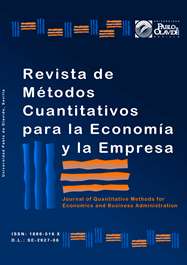Optimal Capital Allocation Based on the Risk Profile of Collective Investment Schemes: An Application of Distortion Risk Measures
DOI:
https://doi.org/10.46661/revmetodoscuanteconempresa.2221Keywords:
Asignación de capital, medidas de riesgo distorsionadas, perfil de riesgo, riesgo agregado, capital allocation, distortion risk measures, risk profile, aggregated riskAbstract
Increasing attention is paid to risk management under the recent regulatory frameworks of the insurance and financial sectors. It is required by the regulator that institutions have a capital to face potential losses from their activity. This capital is usually assessed by means of risk measures. To take adequate decisions, it is essential that managers know how individual risk contribute to the aggregated capital requirement. Techniques of optimal capital allocation are developed to deal with it. This article applies optimal capital allocation criteria in the context of asset management. Our goal is to analyze the liquidity coefficients of Collective Investment Schemes (IIC) belonging to a Management Company of Collective Investment Schemes. In this new context, the risk undertaken by each IIC is assessed with alternative distortion risk measures. We develop a fictitious case where results suggest that the risk profile of institutions should be a key factor to determine liquidity coefficients in order to not penalize conservative strategies.
Downloads
References
Artzner P., Delbaen J., Eber M., Heath D. (1999). Coherent measures of risk. Mathematical Finance, 9, 203–228.
Belles-Sampera, J., Guillén, M., Santolino, M. (2013). Beyond Value-at-Risk: GlueVaR distortion risk measures, Risk Analysis, en prensa.
Buch, A., Dorfleitner, G., Wimmer, M. (2011). Risk capital allocation for RORAC optimization. Journal of Banking and Finance, 35, 3001–3009.
Denault, M. (2001). Coherent allocation of risk capital. Journal of Risk, 4, 7–21.
Denuit, M., Dhaene J., Goovaerts M., Kaas, R. (2005). Acturarial Theory for Dependent Risks. Measures, Orders and Models. Chichester: John Wiley & Sons Ltd.
Dhaene, J., Tsanakas, A., Valdez, E., Vanduffel, S. (2012). Optimal Capital Allocation Principles. Journal of Risk and Insurnace, 79, 1–28.
Filipovic, D. (2009). Term-Structure Models. A Graduate Course. Berlin Heidelberg: Springer.
Hardy, M.R. (2006). An Introduction to Risk Measures for Actuarial Applications. Education and Examination Commitee of the Society of Actuaries, C-25-07.
James, J., Webber, N. (2000). Interest Rate Modelling: Financial Engineering. Chichester: John Wiley & Sons.
Kalkbrener, M. (2005). An axiomatic approach to capital allocation. Mathematical Finance, 15, 425–437.
McNeil, A.J., Frey, R., Embrechts, P. (2005). Quantitative Risk Management. Concepts, Techniques and Tools. Princeton: Princeton University Press.
Tasche, D. (2004). Allocating portfolio economic capital to sub-portfolios, in: A. Dev (ed.), Economic Capital: A Practitioner’s Guide. London: Risk Books, 275–302.
Trigo, E., Moreno, R., de la Peña, J.I., Iturricastillo, I. (2011). Principios de asignación de capital en el ámbito de las entidades bancarias, in: J.M. Feria, E. J. Jiménez and M. Guillén (ed.), Investigaciones en Seguros y Gestión del Riesgo: Riesgo 2011. Madrid: Fundación Mapfre.
van Gulick, G., de Waegenaere, A., Norde, H. (2012). Excess based allocation of risk capital. Insurance: Mathematics and Economics, 50, 26–42.
Wang, S., (1995). Insurance pricing and increased limits ratemaking by proportional hazard transforms. Insurance: Mathematics & Economics, 17, 43–54.
Wang, S., (1996). Premium calculation by transforming the layer premium density. ASTIN Bulletin, 26, 71–92.
Downloads
Published
How to Cite
Issue
Section
License
Copyright (c) 2013 Revista de Métodos Cuantitativos para la Economía y la Empresa

This work is licensed under a Creative Commons Attribution-ShareAlike 4.0 International License.
Submission of manuscripts implies that the work described has not been published before (except in the form of an abstract or as part of thesis), that it is not under consideration for publication elsewhere and that, in case of acceptance, the authors agree to automatic transfer of the copyright to the Journal for its publication and dissemination. Authors retain the authors' right to use and share the article according to a personal or instutional use or scholarly sharing purposes; in addition, they retain patent, trademark and other intellectual property rights (including research data).
All the articles are published in the Journal under the Creative Commons license CC-BY-SA (Attribution-ShareAlike). It is allowed a commercial use of the work (always including the author attribution) and other derivative works, which must be released under the same license as the original work.
Up to Volume 21, this Journal has been licensing the articles under the Creative Commons license CC-BY-SA 3.0 ES. Starting from Volume 22, the Creative Commons license CC-BY-SA 4.0 is used.










